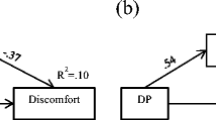Abstract
The purpose of the study was to examine the confidence level in career decision-making of Bahamian adolescents in the high schools in Nassau, Bahamas, investigating factors that influence one's level of confidence in career decision-making. The Career Decision Scale along with a demographic survey were administered to 385 11th and 12th graders to examine six factors which measured the effects and/or interaction effects of influences on confidence in career decision-making. Two MANOVAs and the appropriate follow-up statistics (Tukey's Honestly Significant Difference post hoc tests) were used to determine differences and interaction effects among the variables measuring the level of career decision-making skills. Based on the findings of the study the researcher concluded that for Bahamian adolescents, the type of school, the grade level, and a visit to the school guidance office were significant factors that influenced one's level of confidence in career decision-making.
Similar content being viewed by others
References
Bowers, M. S. (1994). The relationship among achievement orientation, parental communication, and vocational maturity in high school students. (Doctoral dissertation, University of Georgia, 1994). Dissertation Abstract International.
Brown, C., Darden, E. E., Shelton, M. L., & Dipoto, M. C. (1999). Career exploration and self-efficacy of high school students: Are there urban;suburban differences? Journal of Career Assessment, 7(3), 227–237.
Brown, D., Brooks, L., & Associates (1996). Career Choice & Development (3rd ed.). San Francisco, CA: Jossey-Bass.
Chartrand, J. M., & Robbins, S. B. (1990). Using multidimentional career decision instruments to assess career decidedness and implementation. The Career Development Quarterly, 39(2), 166–177.
Chester, N. (1983). Sex differentiation in two high school environments: Implications for career development among black adolescent females. Journal of Social Issues, 39(3), 29–40.
Convoy, C. A. (1997). Influences on career choice of rural youth and resulting implications for career development programming: When job awareness and exploration are not enough. Journal of Vocational Education Research, 22, 3–19.
Fawcett, M. L. (1999). A quantitative study of the effects of vocational programs on career decisiveness levels of high school seniors. (Doctoral dissertation, University of South Carolina, 1999). Dissertation Abstracts International.
Fisher, T. A., & Griggs, M. B. (1995). Factors that influence the career development of african american and latino youth. Journal of Vocational Education Research, 20(2), 57–74.
Gottfredson, L. S. (1981). Circumscription and compromise: A developmental theory of occupational aspirations. Journal of Counseling Psychology, 28(6), 545–579.
Gysbers, N. C. (1996). Meeting the career needs of children and adolescents. Journal of Vocational Education Research, 21(4), 87–98.
Hanna, C. L. (1993). Developmental Guidance and Counselling: An Overview and Practical Suggestions.Nassau, Bah: Ministry of Education.
Johnson, P. (1988). Effective secondary schooling: Factors affecting academic achievement in the commonwealth of the Bahamas. (Doctoral dissertation, University of Toronto, 1988). Dissertation Abstract International.
Kelly, K. R. & Cobb, S. J. (1991). A profile of the career development characteristics of young gifted adolescents: Examining gender and multicultural differences. Roeper Review, 13(4), 202–206.
Kraus, L. J. & Hughey, K. F. (1999). The impact of an intervention on career decisionmaking self-efficacy and career indecision. Professional School Counseling, 2(5), 384–390.
Mason, E. (1994). Work values: A gender comparison and implications for practice. Psychological Reports, 74, 415–418.
Ministry/Department of Education (1998). The National Analysis of Graduates Destination From The Public and Private School System.Nassau, Bah: Ministry/Department of Education.
NCDA Reports (1992). Career counseling competencies. The Career Development Quarterly, 40, 378–386.
Neely, M. (1980). Career maturity inventory interpretations for grade 9 boys and girls. Vocational Guidance Quarterly, 29, 113–124.
Niece, D. E., & Bradley, R. W. (1979). Relationship of age, sex, and educational groups to career decisiveness. Journal of Vocational Behavior, 14(3), 271–278.
Osipow, S. H. (1987). Career Decision Scale Manual. Odessa, FL: PAR, Inc.
Osipow, S. H., Carney, C. G., Winer, J., Yanico, B., & Koschier, M. (1987). The Career Decision Scale 3rd revision. Odessa, FL: PAR, Inc.
Osipow, S. H., & Winer, J. L. (1996). The use of the career decision scale in career assessment. Journal of Career Assessment, 4(2), 117–130.
Perkins, N. R. (1994). Career indecision and high school seniors: Comparing students in the tech prep and general programs of study. (Doctoral dissertation, University of South Carolina, 1994). Dissertation Abstract International.
Powell, D. F. & Luzzo, D. A. (1998). Evaluating factors associated with the career maturity of high school students. The Career Development Quarterly, 47, 145–158.
Rogers, W. B., & Westbrook, B. W. (1983). Measuring career indecision among college students: Towards a valid approach for counseling practitioners and researchers. Measurement and Evaluation in Guidance, 16(2), 78–85.
Rojewski, J. W. (1994). Career indecision types for rural adolescents from disadvantaged and nondisadvantaged backgrounds. Journal of Counseling Psychology, 41(3), 356–363.
Rojewski, J. W., & Hill, R. B. (1998). Influence of gender and academic risk behavior on career decision making and occupational choice in early adolescence. Journal of Education for Students Placed at Risk, 3(3), 265–287.
Roker, D., & Banks, M. H. (1993). Adolescent identity and school type. British Journal of Psychology, 84, 297–300.
Super, D. E., Crites, J., Hummel, R., Moser, H., Overstreet, P., & Warnath, C. (1957). Vocational Development: A Framework for Research. New York: Bureau of Research.
Touma, S. G. (1997). Career maturity and high school students: The effects of four variables on career maturity of high school seniors. (Doctoral dissertation, University of South Carolina, 1997). Dissertation Abstract International.
Watson, M. B., Foxcroft, C. D., & Stead, G. B. (1991). Factor analysis of the career decision scale on South African high school students. Psychological Reports, 69, 1083–1088.
Zunker, V. G. (1994). Career Counseling: Applied Concepts of Life Planning (4th ed.). Pacific Grove, CA: Brooks/Cole.
Author information
Authors and Affiliations
About this article
Cite this article
Rowland, K.D. Career Decision-Making Skills of High School Students in The Bahamas. Journal of Career Development 31, 1–13 (2004). https://doi.org/10.1023/B:JOCD.0000036702.02293.1a
Issue Date:
DOI: https://doi.org/10.1023/B:JOCD.0000036702.02293.1a




